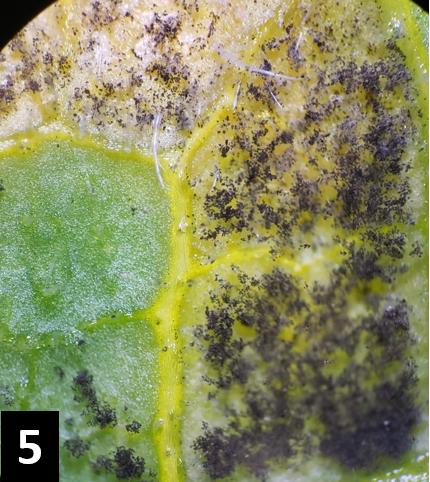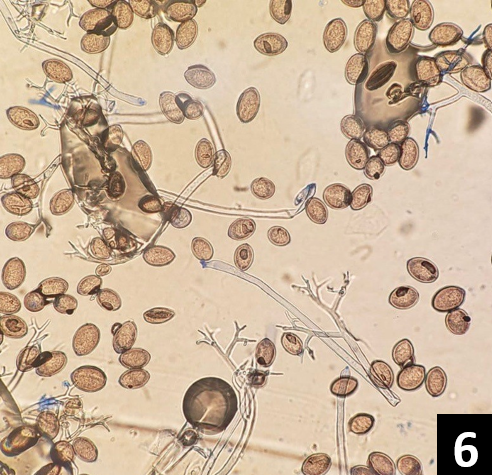Downy mildew disease confirmed on cukes in Lenawee County: Five counties have spores in air samples
All Michigan cucumber and melon growers should spray effective downy mildew fungicides immediately.

Advanced symptoms of cucurbit downy mildew disease on cucumber plants in a commercial planting that had not received downy mildew fungicide sprays have been verified in Lenawee County on June 24, 2025, which is earlier than the last several years. Lenawee County is located in southeast Michigan. The statewide spore trapping network to detect downy mildew spores in the air has had positives for Allegan, Muskegon, Monroe, Bay and Ingham counties.
These results have been confirmed by qPCR. The qPCR results indicate that this is Clade 2, which prefers cucumber and cantaloupe. Clade 1 is rarely found in Michigan and favors watermelon, pumpkin and squash. Only growers of cucumber and cantaloupe need to protect their crops from downy mildew at this time.
Our spore trapping early alert network indicates an influx of downy mildew sporangia across the state, and a strong downy mildew fungicide program is recommended. It is unusual to have so many positive air samples for downy mildew spores from so many counties this early in the season. Hesitating to use the most effective fungicide program right away could result in poor disease control and yield loss. Downy mildew outbreaks have been reported in the southeast U.S. including Alabama, Florida, North and South Carolina and Georgia.
Michigan State University’s spore trap webpage is updated with the latest results of confirmed positives for field disease and spore trap air samples. The results from the spore traps are a few days behind due to the processing of the spore tapes. We can distinguish between cucumber and hop downy mildew spores using molecular tools. Visit the Downy Mildew News page for spore trap results and current downy mildew news. Air samples are processed on Tuesday and Wednesday, with our online report updated each Wednesday evening. Suspect plant samples should be submitted for diagnosis. The positive plant samples can be tracked on our map. See instructions on how to submit samples.
Downy mildew development is influenced, in part, by temperature and moisture (relative humidity and the duration of leaf wetness). The cucurbit downy mildew pathogen (Pseudoperonospora cubensis) prefers cooler temperatures, overcast conditions, high humidity and long dew periods and can rapidly escalate in the state if fungicide sprays are delayed. The recent high dewpoints in the state may have helped the downy mildew pathogen thrive in spite of the high temperatures. The state’s first pickling cucumber plantings must all be protected with fungicide immediately to preserve fruit quality and yield.


It is very important that cucumber growers use proven downy mildew fungicides (shown below in alphabetical order). These fungicides were effective in our 2024 research field plots and include:
- Elumin + chlorothalonil or mancozeb
- Omega (Orbus) + chlorothalonil or mancozeb
- *Orondis Opti (chlorothalonil is part of the premix, additional chlorothalonil is suggested; see label for maximum chlorothalonil rates)
- Previcur Flex + chlorothalonil or mancozeb
- *Ranman + chlorothalonil or mancozeb
- Zampro + chlorothalonil or mancozeb
*Across many years of field tests, Orondis Opti and Ranman have been the leading fungicides in cucurbit downy mildew control in Michigan. They would be especially recommended given the positive downy mildew air samples detected across the state and the positive disease sample from Lenawee County.
Michigan State University Extension recommends alternating fungicides so that resistance of the pathogen to the fungicide’s active ingredient does not develop. It is important that the fungicides be applied prior to plant infection. Waiting until downy mildew has developed in the field prior to applying fungicides can lead to control failure and pathogen resistance. Downy mildew can infect the cotyledons of cucumbers and has been observed in previous years under high disease pressure.
This material is based on work is supported by MSU Project GREEEN, a Michigan Specialty Crop Block administered by the Michigan Vegetable Council, the Agricultural Research Fund and the Pickle and Pepper Research Committee of Pickle Packers International, and the National Institute of Food and Agriculture, U.S. Department of Agriculture, award number 2020-51181-32139.



 Print
Print Email
Email

